After reviewing two different solar generators within the 500-600Wh battery range, I decided to find the best-performing model and test it out to see if it lived up to its specifications.
The EcoFlow River 600 Max had better input and output specifications than the rest, so I bought it and tested it out.
The following are my results.
Overall Score: 8.25/10
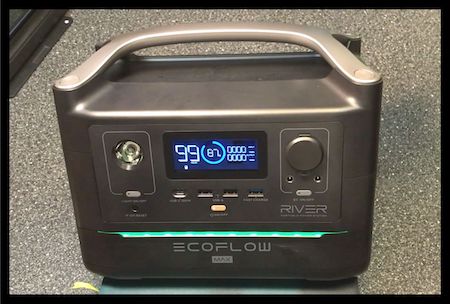
| + Likes | – Dislikes |
|---|---|
| FAST recharging | Heavy (17 lbs) |
| High-powered AC ports | Uses uncommon XT60 input |
| High-tech (EcoFlow App) | Average battery cycle life |
The EcoFlow River 600 Max offers both fast recharging times and powerful output ports. Its intuitive LCD screen and WiFi application make it highly versatile.
However, it’s heavy for its size and has an average battery cycle life. Overall, I recommend the River Max because it clearly outperforms its competition.
With some in-depth testing and a look at the specifications sheet, I scored the River Max according to key qualities I look for in each solar generator system I test.
| Category Analyzed | Max’s Score | Comments |
|---|---|---|
| Battery Lifecycles | 5/10 | 500 cycles to 80%+ is an average cycle life, but you can replace one of the two batteries |
| Output Port Options | 10/10 | 1x 100W USB-C, 2x USB-A, 1x USB-A QC, 3x AC ports, 1x car port, 2x DC5521 ports |
| Recharging Times | 10/10 | From 0-100% battery: 1.6 hrs from the wall; 3 hrs from max solar input |
| Unique Features | 10/10 | EcoFlow App, UPS/EPS function, replaceable battery, X-Stream & X-Boost |
| Internal Build Quality | 10/10 | High-quality charge controller, inverter, BMS + protections, and WiFi connectivity |
| External Build Quality | 9/10 | Grippy handle, advanced LCD screen, rubber grips on bottom, only one output port is covered |
| Weight & Portability | 4/10 | 17 lbs is heavy compared to similar models; average/typical dimensions |
| Price/Value | 8/10 | Average price for battery size – If weight is not a concern, this is probably the best value for your $$ |
| Overall | 66/80 (8.25/10 avg.) | Fast recharging, high output power, and high-tech features make this a one-of-a-kind power station for its size |
The EcoFlow River Max is best for those wanting high-powered AC ports along with portability. It’s expansion battery can be removed to reduce weight for on the go use, plus, it can be paired with your smartphone via the EcoFlow app for use at home.
Overview of the EcoFlow River 600 Max
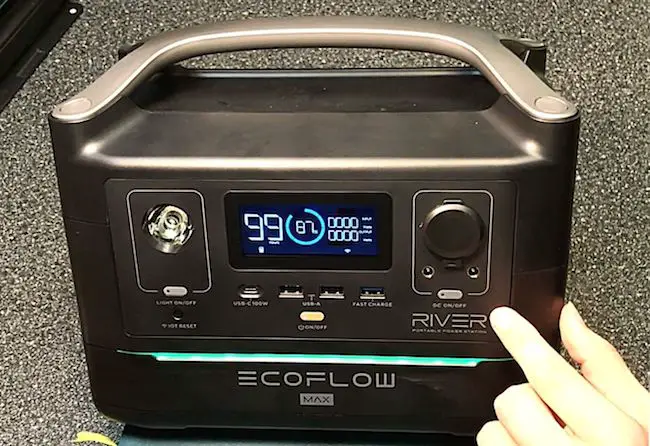
The River Max is essentially a bigger version of the base River power station. Its battery is exactly twice the size of the base River (576Wh vs. 288Wh). The only difference between the two is its additional battery.
There are multiple variations of the River (R600) power station. Before getting into my testing of the River Max, below you’ll find where my River Max lies in the EcoFlow River lineup.
| Model | RIVER Mini | RIVER Mini (Wireless) | RIVER | RIVER Plus | RIVER Max | RIVER Max Plus | RIVER Pro |
|---|---|---|---|---|---|---|---|
| Image | 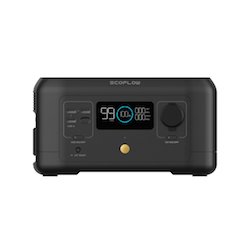 | 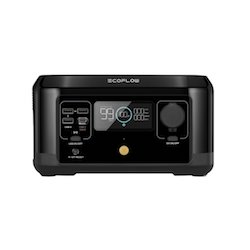 |  | 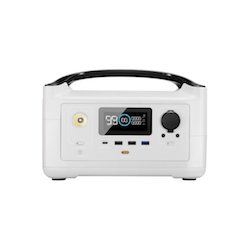 | 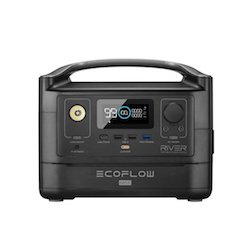 | 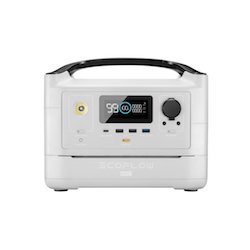 |  |
| Battery Capacity | 210Wh | 210Wh | 288Wh | 360Wh | 576Wh | 720Wh | 720Wh |
| Battery Expansion Available?* | No | No | Yes | Yes | No | No | Yes |
| AC Ports | x2 - 300W continuous (600W surge) | x2 - 300W continuous (600W surge) | x3 - 600W continuous (1,200W surge) | x3 - 600W continuous (1,200W surge) | x3 - 600W continuous (1,200W surge) | x3 - 600W continuous (1,200W surge) | x3 - 600W continuous (1,200W surge) |
| USB Ports | x3 USB-A (5V, 2.4A) | x3 USB-A (5V, 2.4A) x1 USB-C (100W max) x1 Wireless Output (15W max) | x2 USB-A (5V, 2.4A) x1 USB-A Fast Charge (18W max) x1 USB-C (100W max) | x2 USB-A (5V, 2.4A) x1 USB-A Fast Charge (18W max) x1 USB-C (100W max) | x2 USB-A (5V, 2.4A) x1 USB-A Fast Charge (18W max) x1 USB-C (100W max) | x2 USB-A (5V, 2.4A) x1 USB-A Fast Charge (18W max) x1 USB-C (100W max) | x2 USB-A (5V, 2.4A) x1 USB-A Fast Charge (18W max) x1 USB-C (100W max) |
| 12V DC Ports | x1 Car Port (12.6V, 10A) | x1 Car Port (12.6V, 10A) | x1 Car Port (13.6V, 10A) x2 DC5521 Ports (13.6V, 3A) | x1 Car Port (13.6V, 10A) x2 DC5521 Ports (13.6V, 3A) | x1 Car Port (13.6V, 10A) x2 DC5521 Ports (13.6V, 3A) | x1 Car Port (13.6V, 10A) x2 DC5521 Ports (13.6V, 3A) | x1 Car Port (13.6V, 10A) x2 DC5521 Ports (13.6V, 3A) |
| Recharging Times* | AC Wall Charger (100-120V): 1 hr Car Charger: 3.5 hrs Solar Charging @ Max Input (100W): 2.1 hrs | AC Wall Charger (100-120V): 1 hr Car Charger: 3.5 hrs Solar Charging @ Max Input (100W): 2.1 hrs | AC Wall Charger (100-120V): 70 min Car Charger: 3.5 hrs Solar Charging @ Max Input (200W): 1.5 hrs | AC Wall Charger (100-120V): 96 min Car Charger: 4.5 hrs Solar Charging @ Max Input (200W): 1.8 hrs | AC Wall Charger (100-120V): 70 min Car Charger: 6.5 hrs Solar Charging @ Max Input (200W): 2.9 hrs | AC Wall Charger (100-120V): 96 min Car Charger: 8 hrs Solar Charging @ Max Input (200W): 3.6 hrs | AC Wall Charger (100-120V): Car Charger: 8 hrs Solar Charging @ Max Input (200W): 3.6 hrs |
| Battery Cycle Life | 500 cycles to 80% capacity | 500 cycles to 80% capacity | 500 cycles to 80% capacity | 800 cycles to 80% capacity | 500 cycles to 80% capacity | 800 cycles to 80% capacity | 800 cycles to 80% capacity |
| Check Price (Affiliate Links) | Amazon | Amazon | Amazon | EcoFlow | Amazon | Shop Solar Kits | Amazon Shop Solar Kits |
*(Battery Expansion): All RIVER models with battery expansion have optional additional batteries that double their originally listed capacities.
*(Recharging Times): The listed solar input and recharging time is based on the maximum solar input - not the solar panel rated power output (Ex: a 100W solar panel usually produces about 80W of actual power in good sunlight).
All EcoFlow River 600 models have the same set of inputs and outputs except for the River Mini.
Similar: EcoFlow vs. Jackery – Full Solar Generator Comparison (With Specs)
What Does the EcoFlow River Max Come With?
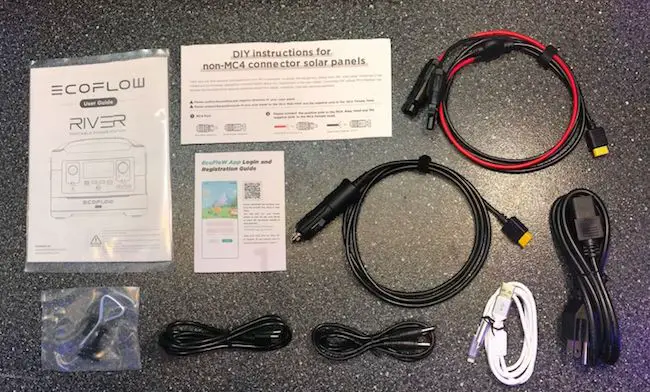
The River Max comes with the following accessories:
- MC4 to XT60 cable (for solar panel charging)
- Auxiliary to XT60 cable (for car charging)
- AC wall charger
- USB-A to Micro-USB and iPhone charger
- USB-C to USB-C cable
- DC5521 to DC5521 cable
- Power Earth screw (to ground the R600 if needed)
The accessories are plentiful compared to several other power stations I’ve bought or received. Usually, you can expect to get a wall charger and in most cases a car charger with any power station.
A quick tip for using third party solar panels with this power station: the included MC4 to XT60 adapter uses a positive male and negative female connector on the MC4. If the solar panel you intend to use with this model uses an MC4, make sure it has a negative male and positive female connector – otherwise you may need to purchase a separate adapter for a proper connection.
AC, DC, and USB Output Testing – EcoFlow River Max
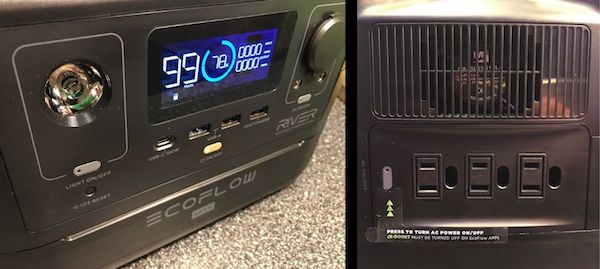
Testing the AC Ports
The AC ports worked phenomenally. I knew that they were powerful before testing it, but after getting my hands on the River and testing them myself, I couldn’t find an AC appliance that was powerful enough to fully test the River 600’s capabilities.
To put the River Max’s AC power output in perspective, its X-Boost feature doubles its standard rating of 600W to power appliances continuously at 1,200W.
This is a higher continuous output than the Jackery Explorer 1000, which is not normal for a 500-600Wh solar generator like the River.
Below is my screenshot of testing the River’s AC port with a hairdryer. I had just clicked the maximum setting on it and it surged for less than a second to 1,182W before dropping to around 660W.
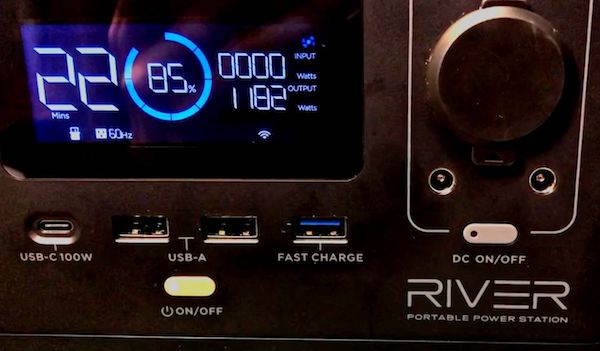
I tested the EcoFlow River Max with the following:
- Jackery Explorer 1000 wall charger
- Heat gun (1,200W rated surge)
- Hair dryer (1,875W rated surge)
The River Max successfully powered all of the above. Below you’ll find the wattages I received when using them with my River.
| Device/Appliance | Max Continuous Discharge | Starting Surge Received |
|---|---|---|
| Jackery 1000 Wall Charger | 160-180W | N/A |
| Heat Gun | 588W | 1,009W |
| Hair Dryer | 660W | 1,182W |
Unfortunately, I was not able to test the full capabilities of the power station because I didn’t have an appliance that was powerful enough to get 1,200W of continuous power.
With EcoFlow’s X-Boost feature enabled via the app, you can power devices up to 1,200W continuously. EcoFlow recommends only using one AC port when using the X-Boost mode.
What’s great about this power output is that you can use it with several high-powered appliances that run on 120V.
I own the Rockpals 500 and OUPES 600W portable power stations (both with 500-600Wh batteries) and they both cannot compete with EcoFlow’s X-Boost technology.
USB Ports Testing
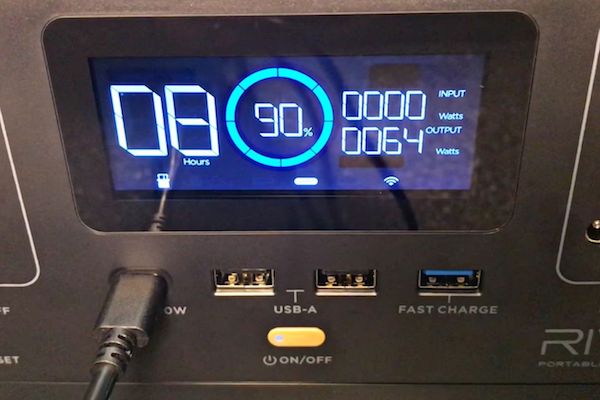
I first tested the USB-C (100W) port and it worked perfectly on my Sherpa 100AC power bank.
The Sherpa takes in a maximum of 60W of input and the River supplied exactly 60W of power to the Sherpa. This was especially impressive to me because the River outputted 64W of power to the Sherpa.
Due to efficiency losses from the USB-C cable, the 64W actually supplied a consistent 60W of power to the Sherpa.
This gives me confidence that the 100W USB-C port will give its full 100W to whatever it is charging.
My guess is that most people will use the full 100W to charge their laptops, and with this amount of power available, the River supplies more USB-C power than any other portable power station that I know of from another company.
As for USB-A ports, there are two standard USB-A ports that deliver a total of 12W maximum. There is also one USB-A fast-charge port that outputs up to 18W of power.
I didn’t have a device that would access the full 18W of the fast charge USB-A, but all three USB-A ports worked well and delivered 10-12W of power to my Sherpa power bank. I use the Sherpa because it measures the wattage coming into it.
The one point I struggled with was inserting my USB-A cables into the River’s ports.
Since my River was brand new at the time of testing, these ports were very hard to work with at first.
After continued use (3-5 tests inserting and reinserting) of the USB-As, they fit easily into their ports.
DC 12V Ports Testing
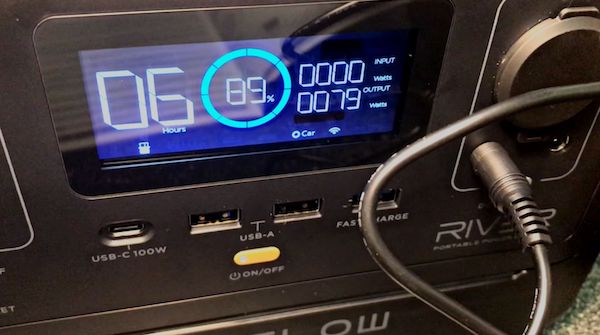
The DC ports section has three 12V ports: two DC5521 outputs and one car port output.
All three outputs are regulated at 13.6V.
I used my Jackery 1000‘s car charger to test the River Max, and it outputted about 80W, which is the maximum amount of power that the Jackery cable will allow.
The car port can deliver up to 136W (13.6V, 10A max) but I didn’t have a car port cable that could test the limits of this port.
Next, I tested the DC5521 ports to see if they could deliver – and they actually exceeded my expectations by a long shot.
I used the included 5521-to-5521 cable to charge my Jackery 1000 (I used an adapter to do so).
The rated output for each of these ports is 13.6V, 3A max. At its best, this equals about 40W of output capability.
I received 80W from a single DC5521 port when charging my Jackery power station with the River Max.
Since this is double the rated power output of one 5521 port, I assume this amount of power came from me only using one of the two ports – therefore combining their amperage to six amps instead of three.
This means that if you had an appliance like a CPAP machine that needed more than 40-80W of power to work, then you might be able to use it with the River’s 5521 output.
Since I often don’t use the car port or 5521 output ports on my portable power stations, I have no use for them currently.
However, if I needed to use them down the road, I know that the River Max will be the ideal power station to work with out of the several systems I own.
Similar: Top 5 Solar Generators for CPAP Machines (500+Wh)
Combined Discharge Testing (DC and USB)
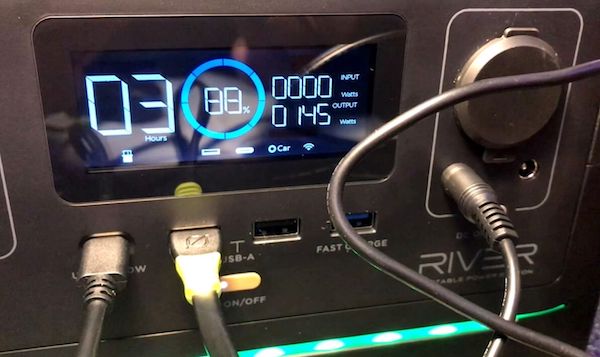
Using the USB-C port, a single USB-A port, and the DC5521 port, I charged my devices with no issues and received about 145W of continuous output from all ports combined.
I did this to see if any power losses would occur when combining outputs.
All power outputs used maintained their output wattage in the same manner as they did when testing each one out individually:
- My Sherpa 100AC power bank received its 60W maximum from the USB-C port
- My Jackery 1000 got its 80W of power from the DC5521 port
- My earbuds got the remaining 5W of power from the USB-A port
How Do You Charge an EcoFlow River?

The EcoFlow River charges via three sources: wall charging, car charging, and solar charging. The included wall charger plugs into the “X-Stream charge” input. The included car charger plugs into your car port and connects to the River’s XT60 input. The XT60 input is also used for solar charging.
On the EcoFlow app, you can choose whether or not to slow charge the River 600. Doing so will reduce the noise from the cooling fans.
You can also choose the level at which you’d like your River to stop charging. EcoFlow recommends using this feature to stop charging at 80% to prolong the overall lifespan of the battery.
Solar Charging My R600

On a cool morning in the fall, I took out my two Elecaenta 120W solar panels to connect to the River Max.
In order to connect my solar panels to the River, I needed two adapters which I bought separately.
One was an 8mm to Anderson Powerpole adapter (affiliate link), which connected the solar panels into one Anderson output.
The second adapter was an Anderson to XT60 which allowed me to connect to the River.
These totaled about $30 in additional expenses.
If you have an EcoFlow solar panel (affiliate link), you do not need to worry about getting any adapters.
This is also the case if you have solar panels with MC4 connectors as EcoFlow provides an adapter for you as seen below.

My results from solar charging were excellent – the average amount of sun received was about 170W.
Since the River can take in up to 200W, this was relatively close to the max input.
The highest output I got from the solar panels was 180W. To get this output I adjusted the angle of the panels to be better aimed towards the sun. I put some rocks underneath the solar panel kickstands to get the right angle.
The River Max handled the charging with no issues.
The cooling fans turned on shortly after I began charging, and after about 20-30 minutes of charging, the fan held the same steady speed and low noise level since being turned on.
How Do You Connect EcoFlow Solar Panels?
EcoFlow solar panels connect via an MC4 connector. Connect the solar panel’s MC4 to the MC4-to-XT60 cable that comes with your EcoFlow power station. Once connected, plug the yellow XT60 end into your EcoFlow power station’s solar input.
To connect two EcoFlow solar panels to your power station, use an MC4 parallel connection cable to combine both solar panel connections into a single MC4 (male and female) connection. Then, use the MC4-to-XT60 adapter to connect the panels to your power station.
Can I Use Any Solar Panel with EcoFlow?
You cannot use any solar panel with EcoFlow power stations, however, there are several options you can choose from. The solar panel’s output must be within the power station’s allowable voltage range and must not exceed its maximum amperage.
Once these parameters are met, you need to make sure you have the correct adapters to plug the solar panel into your EcoFlow system. If your solar panel uses anything other than an MC4 connector, you will need to purchase an adapter that has a female XT60 connection.
For my own setup, I use two Elecaenta 120W solar panels that connect to my River power station in the following format:
- Attach an 8mm adapter onto each Elecaenta cable (this comes with the panel)
- Use an 8mm-to-Anderson Powerpole parallel adapter cable to connect each solar panel
- Connect the parallel adapter’s Anderson Powerpole end to an Anderson-to-XT60 adapter
- Connect the XT60 end into the River power station
Your setup may be different depending on the solar panel you buy and how many panels you intend to use.
AC Wall Charging

Wall charging is a very simple process. Simply connect the River to its wall charger and plug it in. I tested its input power and got the following results:
- When the battery was at about 60%, it recharged at a rate of 400-430W
- When the battery was at 87%, it recharged at a rate of about 300W
This is a huge number compared to similar systems. For example, my Rockpals Rockpower 500’s AC charger only outputs 72W maximum, and my OUPES 600W power station charges at a 96W maximum from the wall.
With this amount of power, the River Max will recharge in 1.6 hours from 0-100% and in one hour it will recharge from 0-80%.
From my testing and compared to the numbers above, it seems as though the wall charger outputs more power to the River when charging from 0-80% and then reduces its power when charging from 80-100%.
As for noise levels, the River’s cooling fans were not loud but they were not quiet. It was somewhere in between. My Jackery 300 and OUPES 600W systems are less noisy.
Another noise I noticed was a slight whine inside the River. I didn’t hear this with my other power stations, but it was present and was sort of background noise behind the cooling fans.
Car Charging
The included car charger worked flawlessly with the River Max.
I received 116-118W of power consistently, which is the highest car charger wattage I’ve tested compared to the OUPES 600W and Jackery 300.
There is no indicator light on the auxiliary end of the car charger, so you’ll need to make sure that it fits snug inside your car port outlet.
Similar: Top 5 Fastest Charging Solar Generators (Via AC Outlet & Solar Panels)
EcoFlow River Max – Construction Analysis (Internal & External)
This section has everything to do with quality standards being met for both the external materials used and internal components.
External Layout

The outside of the R600 is made from ABS plastic. Its carrying handle is made of the same material and is easy to grip. There is an area underneath the handle that can be used to store devices while they are being charged.
There are port covers on the input section of the power station as well as the 12V car port. The other output ports are not covered.
On each side, there are sturdy cooling vents made of ABS plastic.
I can press on them with some decent force and there is no wobble. This is important as these vents tend to be the weakest parts of portable power stations in general.
The AC ports are located on the side of the R600 and on the back of the system there is nothing.
On the bottom of the power station are four rubber “legs” or stoppers that keep it in place when being set on hard surfaces.
Within each of these rubber stoppers is a screw; when each screw is loosened and removed, you can take off the 288Wh added battery.
If you want to you can remove the extra battery and screw in the bottom piece of the River Max to condense your power station’s weight and size. With the battery removed you will have the exact same system as the standard EcoFlow River 600.
This can be useful if you want to make your River Max more portable for an off-grid adventure. Doing so will reduce weight and make it easier to move around if needed.
LCD Screen
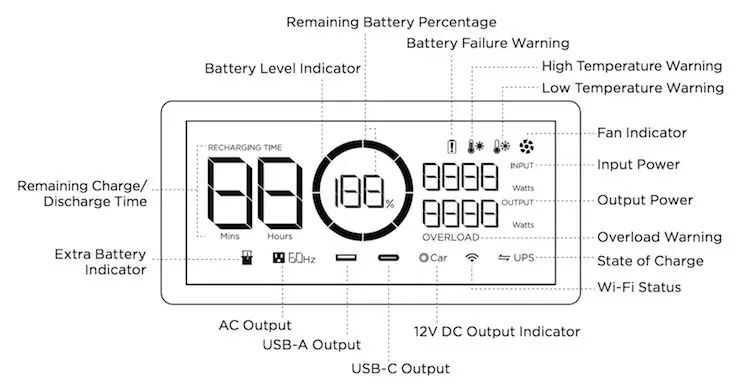
The LCD screen has several indicators and data points that are useful when using the River.
The numerical data points that are shown on its screen include:
- Input wattage
- Output wattage
- Estimated hours/minutes until recharged or discharged
- Battery percentage
There are also several icons used within the LCD screen, including:
- Port usage indicators
- Wifi signal (to use with EcoFlow app)
- UPS (uninterruptible power supply) icon
- Cooling fan indicator
- Temperature warnings
- Protection information
Protection information is used to indicate if there is an issue with specific components within the power station. There are several different warning icons inside the River 600 manual, but they do not all have individual icons for each protection measure.
Instead, the River uses a combination of icons to indicate the issue.
For example, if the high-temperature icon and the USB-C icon are flashing together, this indicates that the USB-C’s high-temperature protection is active – The corrective measure in the manual is to simply let the River Max cool down before adding appliances back to the power station.
There are a total of 18 different protective warnings (not including the high and low-temperature warnings).
LED Light
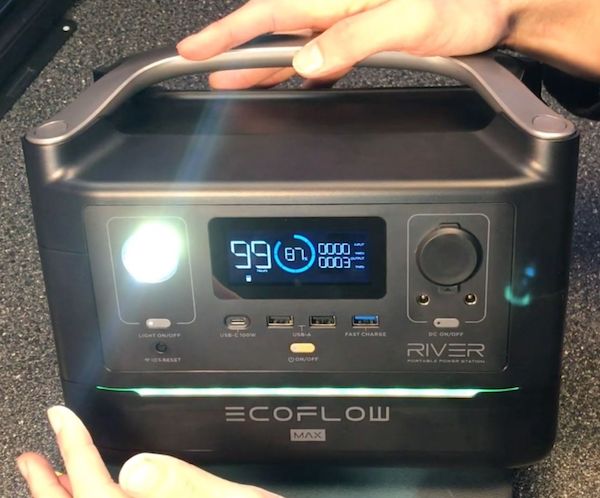
The LED light on the River has three modes: normal, bright, and SOS. The light is quite bright even in its standard setting.
You can turn the light on and off and shift between its modes in the EcoFlow application, as I did on my phone.
This light can be useful if you need it at night whether during a power outage at home or while camping out.
Internal Components
Inside the River 600 Max there are a number of advanced components:
- Charge controller
- Removable Battery
- Battery Management System (BMS)
- Battery protection systems
- WiFi connection for mobile app
- Inverter
- Output ports
I’ll discuss some of these components to give you a better idea of why they are advanced.
Charge Controller
Although it is not listed whether it houses an MPPT or PWM controller, the River has a dominating AC charging rate and it can take in up to 200W of solar panel input.
This is higher than nearly all other solar generators in the same size class, as seen below.
| Solar Generator Model | Max Solar Input | AC Adapter Charging Rate |
|---|---|---|
| Jackery Explorer 500 | 100W | 80W max |
| OUPES 600W | 100W | 96W max |
| Rockpals Rockpower 500 | 120W | 72W max |
| Goal Zero Yeti 500X | 150W | 60W max |
| EcoFlow River 600 Max | 200W | 500W max |
Removable Battery
Half of the River Max’s battery capacity comes from a removable battery (288Wh). This makes the River Max a versatile portable power station because you can save weight by removing the added battery – essentially creating the standard River 600.
This is uncommon in portable power stations because it’s much easier to create a system that has one battery that can’t be replaced or removed.
There are less than a handful of other solar generators that have a similar modular design as the River Max – the most well-known being the Titan and Inergy Flex power stations.
Inverter
The pure sine wave inverter in the River Max is used to convert DC power from the battery to AC power for the AC output ports.
Since the River outputs and inputs an extensive amount of AC power, the inverter needs to be powerful enough to convert all of this energy efficiently and effectively.
Although I don’t know the exact specs of the River’s inverter, it can handle a ton of power compared to similar 500-600Wh solar generators.
Overall, the River 600 Max is made with quality materials and components – both inside and outside the power station.
Another example of a solar generator built with quality in mind is the Titan solar generator by Point Zero Energy. The Titan has a metal frame, two charge controllers, and a modular design for additional batteries.
It’s much bigger than the R600 Max and is ideal for higher power needs. You can check out my Titan article here for more information: Titan Solar Generator Review – The Best Large Solar Generator?.
EcoFlow App – Key Takeaways from My Experience
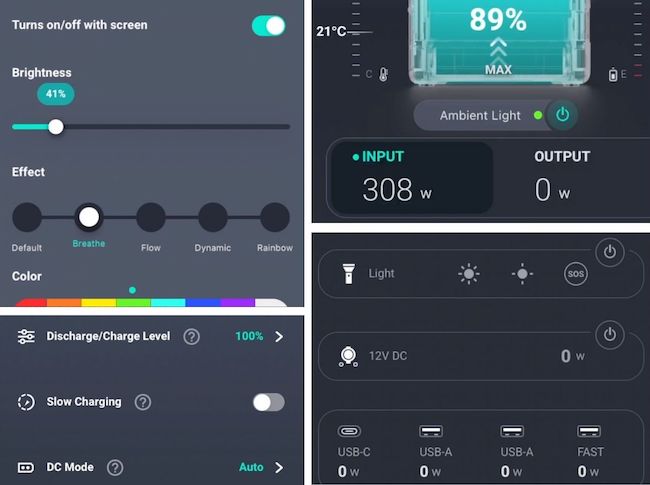
The EcoFlow app is used to control and manage compatible River and Delta portable power stations via WiFi. Available for both Android and iOS operating systems, the app controls output ports (on/off), light settings, slow charging or X-Stream charging, and X-Boost mode.
I connected my River Max to my WiFi network by following the steps given in one of the manuals.
It was pretty easy to connect but it took some time to get it fully connected.
The basic data that can be seen on the LCD screen is shown on the app, but there are also several other controls that can be used to customize the River to your liking.
This includes:
- Turning on and off output ports and the LED light
- Customizing the ambient light (color, pattern, and brightness)
- Managing charging levels (can set it to stop recharging once it reaches 80%)
- Turning on and off the X-Boost mode for the AC ports
- Slow recharging setting (minimizes fan use)
- DC Mode (choose input source manually if needed)
I used the application to turn ports on and off, change the ambient light color, and to turn on X-Boost mode.
Although I haven’t used all of the available settings, I can see different times where I would want to use them in the future.
Overall, the app is practical when you:
- Want to manage it from another room in your home
- Want to recharge it a certain way
EcoFlow also has periodical updates to the application’s firmware, so more functions are expected to come with each update.
The only other company with an application for their portable power stations is Goal Zero. However, only their larger Yeti solar generators have this feature, including the 1400 Lithium, 3000 Lithium, 1500X, 3000X, and 6000X.
EcoFlow River 600 Max vs. Similar Solar Generators
Below I’ve compiled three similar solar generators to the River Max. They are around the same battery capacity of 500-600Wh.
Check out the table below for their similarities and differences and then I’ll discuss some of them afterward.
| Model | EcoFlow River 600 Max | Jackery Explorer 500 | Rockpals Rockpower 500 | OUPES 600W |
|---|---|---|---|---|
| Image | 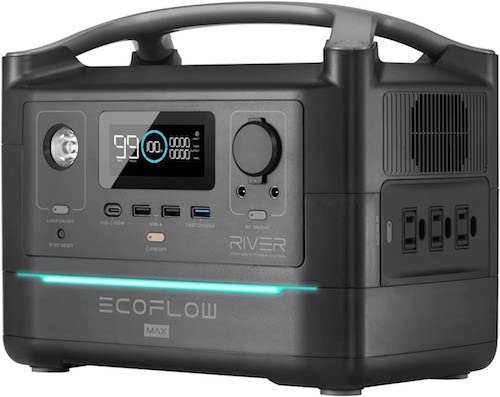 | 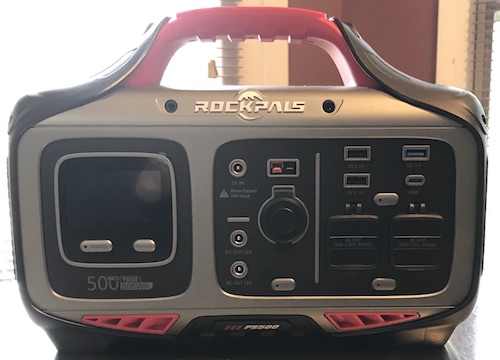 | 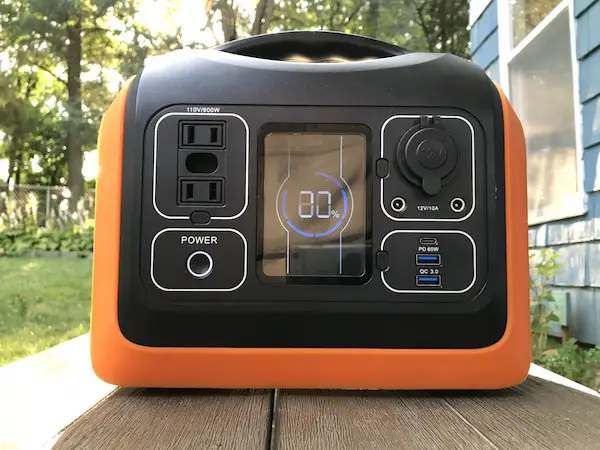 |
|
| Battery Capacity | 576Wh | 518Wh | 505Wh | 595Wh |
| AC Ports | x3 - 600W continuous (1,200W surge) | x1 - 500W continuous (1,000W Surge) | x2 - 500W continuous (750W surge) | x2 - 600W continuous (1,000W Surge) |
| USB Ports | x2 USB-A (5V, 2.4A) x1 USB-A Fast Charge (18W max) x1 USB-C (100W max) | x3 USB-A (5V, 2.4A) | x2 USB-A (5V, 3.1A) x1 USB-A QC (18W max) x1 USB-C PD (45W max) | x2 USB-A QC (18W max) x1 USB-C PD (60W max) |
| Max Solar Input | 200W | 100W | 120W | 100W |
| Recharging Times* | AC Wall Charger (100-120V): 96 min Car Charger: 6.5 hrs Solar Charging @ Max Input: 2.9 hrs | AC Wall Charger: 7.5 hrs Car Charger: 7.5 hrs Solar Charging @ Max Input: 5.2 hrs | AC Wall Charger: 7-8 hrs Car Charger: 7-8 hrs Solar Charging @ Max Input: 4.2 hrs USB-C PD: 11-11.5 hrs USB-C PD + AC Charging: 4.3-5 hrs | AC Wall Charger: 6-6.5 hrs Car Charger: 12 hrs Solar Charging @ Max Input: 6 hrs USB-C PD: 10.5 hrs USB-C PD + AC Charging: 4 hrs |
| App Control Via Wi-Fi? | Yes | No | No | No |
| Battery Type | Lithium-ion | Lithium-ion | Lithium-ion | LiFePO4 |
| Weight | 17 lbs | 13.3 lbs | 12.3 lbs | 15 lbs |
| Battery Lifecycles | 500 cycles to 80% capacity | 500 cycles to 80% capacity | 500 cycles to 80% capacity | 3,600 cycles to 80% capacity |
| Price | $450-$500 (Link to Shop Solar Kits) | $450-$500 (Link to Amazon) | $385-$485 (Link to Amazon) | $400 (Link to Amazon) |
*(Recharging Times): The listed solar input and recharging time is based on the maximum solar input - not the solar panel rated power output (Ex: a 100W solar panel usually produces about 80W of actual power in good sunlight).
I didn’t include the Yeti 500X in this comparison, but if you’d like to directly compare it to the River Max I have a brief review of it here: Yeti 500x by Goal Zero – Overview & Stats – Peak Performance.
Strongsuits
The River Max has a few elements that make it better than the others:
Faster Recharging Times
- Car charging is faster than the rest
- Solar charging is over an hour faster than the second-best option (Rockpals Rockpower 500)
- Wall charging is 4x faster than the second-best option (OUPES 600W)
More (and Better) Output Ports
- The River’s ten outputs put it one above the Rockpals 500 due to the River’s additional AC port
- Its 100W USB-C is 40W better than the OUPES 60W option and the Rockpals’ 45W option
- The AC ports on the River have a higher continuous and surge rating (not including X-Boost mode, which is even higher)
Mobile Application
- None of the other power stations have a mobile app
- Goal Zero has an app for some of their power stations, but their Yeti 500X (closest in battery size to the River Max) doesn’t have this feature
Other positive elements that are not in the table include:
- Removable/replaceable battery – None of the others have this feature, which allows you to remove the battery to make it more portable (removes 5.5 lbs)
- LCD screen – The only power station from the table that competes with the River Max is the OUPES system
- UPS/EPS function – The River can be used as an Emergency Power Supply to support your devices when grid power goes out (the others don’t have this)
Setbacks
Although the River Max has mostly upsides compared to its competition, there are two downsides that come into play.
1. Weight
The River Max is two pounds heavier than the OUPES 600W system and 4-5 pounds heavier than the Jackery 500 and Rockpals 500.
However, the OUPES power station uses a LiFePO4 battery, which tends to be heavier than lithium-ion ones.
This makes the River Max about 25% heavier than its lithium-ion competition.
2. Battery Lifecycles
It may not necessarily be a large drawback, but the River Max has 500 cycles to 80% battery capacity.
The reason I say it’s not a significant setback is that both the Jackery 500 and Rockpals 500 have the same battery life expectancy.
However, the OUPES 600W has over seven times the battery cycle life than the River and the others in the comparison (3,600 cycles).
This massive increase has to do with the OUPES’ LiFePO4 battery – and since these batteries, in general, provide a much longer lifespan than lithium-ion ones, solar generator companies are beginning to produce more batteries with LiFePO4 cell chemistry.
The main point is that the River Max’s battery is currently average in terms of longevity.
But since battery lifecycles are a crucial part of the overall value of a solar generator, it is still a setback due to the emerging LiFePO4 power stations.
For more information on LiFePO4 solar generators, I have an article ranking and comparing six different models. You’ll see which ones provide the most long-term value as well as the ones I don’t recommend: 6 Best LiFePO4 Solar Generators (Stats, Pricing, and Analysis).
The closest competitor to the River Max in terms of performance is the Bluetti EB55. I reviewed it and compared it directly to the EcoFlow model in this post. You can check it out here: Test & Review: Bluetti EB55 Solar Generator (In-Depth).
EcoFlow River 600 vs 370 (Previous Iteration)
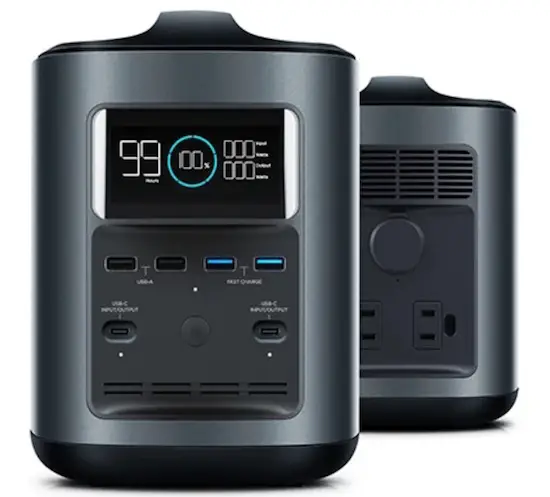
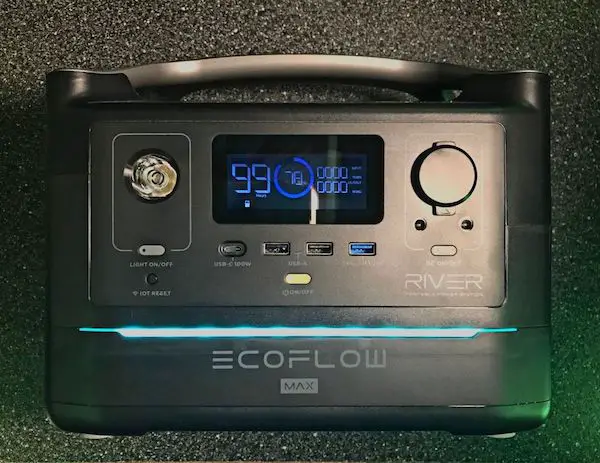
The EcoFlow River 600 is better than the River 370 due to several improvements including faster wall and solar charging, more powerful AC ports, optional battery expansion, and WiFi connectivity (via the EcoFlow app) to pair your mobile device to the River 600.
The table below compares the standard 288Wh River 600 to the River 370.
| Model | EcoFlow River 600 | EcoFlow River 370 |
|---|---|---|
| Battery Size | 288Wh | 370Wh |
| Battery Expansion | Yes; Can double to 576Wh | Not available |
| Output Ports | 2x USB-A, 1x USB-A QC, 1x USB-C, 1x Car Port, 2x DC5521 ports, 3x AC ports | 2x USB-A, 2x USB-A QC, 2x USB-C PD, 1x Car Port, 2x AC ports |
| Input Ports | 1x AC (X-Stream) port 1x XT60 port | 2x USB-C PD ports |
The River 370 has a bigger battery than the River 600 by nearly 100Wh but the River 600 can expand its battery to 576Wh to form the River 600 Max.
There are six total USB ports on the River 370 while the River 600 has four. The two 60W USB-C PD ports on the River 370 function as both inputs and outputs, whereas the single 100W USB-C on the River 600 is only an output.
With an additional AC port and two DC5521 ports, the River 600 has ten total ports to the River 370’s nine.
The biggest differences between these two systems (other than their USB ports) are recharging times, inverter strength, and the EcoFlow application.
You can’t connect your phone or tablet to the River 370 as it was created before EcoFlow developed its mobile application.
The AC inverter in the River 370 has a 300W continuous, 600W surge rating, yet the River 600 has exactly double this output; and with the X-Boost feature turned on, the River 600 can deliver 1,200W of continuous AC power.
It takes only 70 minutes for the standard River 600 to charge from the wall, but the River 370 takes six hours to perform this task.
You can double the River 370’s input to 120W by using the additional USB-C PD port – resulting in a three-hour recharge time.
Solar charging is simple with the River 600 as it has an XT60 input.
The River 370 solely uses its USB-C PD ports to recharge – this means that you can use a solar panel to connect to either port or both of them.
EcoFlow has a 110W and 160W solar panel that will connect to the River 600 via an MC4-to-XT60 connector (included with the River 600). For the River 370, EcoFlow sells an MC4-to-USB-C adapter for solar charging.
The River 370 is no longer available ever since the River 600 came out as its successor.
Frequently Asked Questions – EcoFlow River 600 (Base, Max, & Pro)

With so many unique features within the EcoFlow River, there are a multitude of different questions that you may have. Below are some of the common questions that I’ve answered for you.
How Long Does the EcoFlow River 600 Last?
The EcoFlow River 600 Mini, River 600, and River 600 Max last for 500 cycles to 80% battery capacity. The EcoFlow River Plus, River Max Plus, and River Pro last for 800 cycles to 80% battery capacity.
The River 600 and River Plus can expand their battery capacities with an optional battery that is installed on the bottom of the unit. This turns the River 600 into the River 600 Max and the River Plus into the River Max Plus.
The River Pro has an optional external battery that doubles its battery capacity. This external battery is connected via a cable as opposed to the River and River Max’s expandable battery (located underneath the system).
Overall, the River series of solar generators will last longer if you:
- Properly maintain the power station (clean it, store it in ideal conditions, use it within its input/output range, etc.)
- Don’t use it on a daily basis
- Recharge it often (especially before storing it)
- Don’t simultaneously recharge and discharge it
- Purchase an expandable battery
How Many Watts Is the EcoFlow River 600?
The standard EcoFlow River 600 has a 288Wh (watt-hour) battery capacity. The River 600 Max is rated at 576Wh and the River 600 Pro has 720Wh of battery power available when fully charged. Each of these power stations has the same AC output of 600 watts continuous (1,200W surge).
The EcoFlow River Mini has a 210Wh battery and shares the same AC output rating as the previous iteration, the River 370 (300W continuous, 600W peak).
The EcoFlow River Plus carries a 360Wh battery, while the EcoFlow River Max Plus (affiliate link) has a 720Wh battery. Both of these power stations have a 600W continuous AC output rating with a 1,200W surge maximum.
Can the Ecoflow River Jump-Start a Car?
No EcoFlow River models cannot jump-start a car. However, if you have a 12-volt connector that connects your car’s battery to an auxiliary port, you can use the auxiliary/car port on the River models to recharge your car’s battery.
There are no portable power stations that can jump-start a car. This is because jump-starting a car requires hundreds of amps at once. The typical output port on a power station that carries the highest amperage is its car port, which outputs only 10A.
A tool that I use that will jump-start my car is the Fanttik T8 Apex. I’ve used this portable jump-starter on more occasions than I can count to start my car’s battery.
You can read more about the Fanttik jump-starter in my review article here: Fanttik T8 Apex Car Jump Starter Review (Testing & Comparison).
Is the EcoFlow River Waterproof?
The EcoFlow River is not waterproof. All River models are susceptible to water damage because most of their ports are not covered. Only the car port output on the River is covered.
No portable power station is waterproof because they need ventilation, which exposes the power station to the elements. In addition, most power stations have exposed input and output ports making them vulnerable to water damage.
However, some power stations have multiple port covers that help prevent water damage. One example is my Rockpals Rockpower 500, which has an AC port and car port cover. It also has side vents that are angled downward to prevent rain damage.
The solar generator with the most port covers is the Lion Energy Safari LT, which has five port covers for its input ports and DC outputs. However, this system is also vulnerable to rain damage as its side vents and AC ports are fully exposed.
Can you use any solar panel with EcoFlow River?
The EcoFlow River can be used with any solar panel as long as it’s within the River’s maximum input level of 200W (25V, 12A). The River uses an XT60 input, so an adapter may be needed to connect the solar panel(s) into the power station.
I personally use my Elecaenta 120W solar panels to charge my River Max. I use a DC7909 to Anderson Powerpole to connect the two panels into one power source. Then, I use an Anderson Powerpole to XT60 to connect my panels to the River.
Conclusion – Is the EcoFlow River Max Worth It?
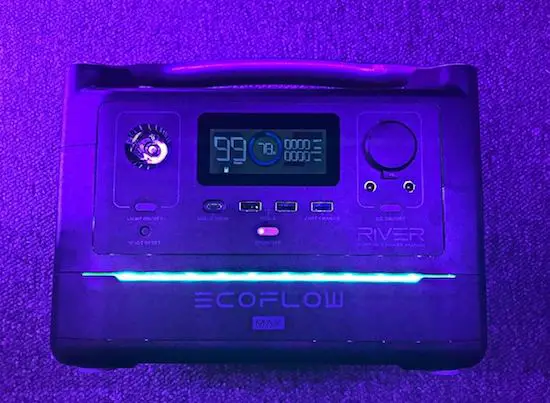
EcoFlow’s River 600 Max is worth it because it is powerful and versatile. Compared to its competition, the only things setting it back are its weight and battery cycle life.
The weight can be altered by removing the external battery to get the River to about 11-12 lbs if needed.
Everything else about this system is at the very least above average.
I can definitively say that this power station has the most powerful AC ports, the highest solar input, and is the most technologically advanced system for its size.
I will be keeping the River Max for a long time.
For my first-hand testing and results, I have my YouTube review and analysis below:
If you’re looking for the River 600 Max, I recommend checking it out and comparing prices via the buttons below. As stated earlier, I bought mine from Shop Solar Kits because it was the cheapest price I found – this is including shipping and taxes.
If you want a 500-600Wh power station that will last as long as possible, I recommend reading my article on the OUPES 600W power station.
Although it is not as powerful as the River Max, its battery lasts 7-8 times longer. You can find my review of it here: OUPES 600W Portable Power Station (Review & Testing).
If the River 600 Max is too complicated for you or has too many extra features, I have a review of a solar generator kit (power station + panel) that is extremely simple. Read my review here: BigBlue Cellpowa500 Power Station + 100W SP100 Solar Panel Review.
Similar articles:



